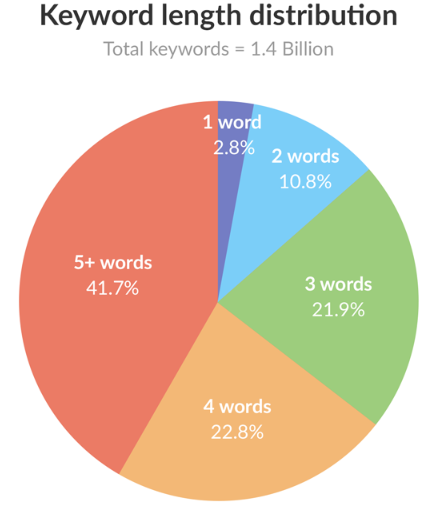How Internet searches have changed
.
Today, more than half of the searches performed contain four or more words according to a study by ahrefs. As you can see in the graph below, 41.7% of searches are now conducted with more than 5 words. The long-tail keywords or long-tail keywords are becoming more and more frequent. In addition, voice searches have also influenced this trend.

Information source: ahrefs study
.
Think about it. Faced with so much quality content on the Internet, users need to narrow down the information they receive in some way. For example, your potential customers are not going to search for “crm” because they know they can receive diverse information from “zoho crm” to “what is crm” when that is not what they are looking for.
{{cta(‘bb2971b9-bf36-4c36-8edc-75223dba5208’)}}
For this reason, the trend of searches with longer terms is on the rise. Now your potential customers know they can search for “crm software for hotels” or “crm solutions for hotels” to get much more specific results that offer more accurate content to what they want to consume.
How search engines have adapted
.
By now you should know that Google’s algorithm is continually changing to adapt to information consumption trends. Sometimes, those changes do not significantly affect SEO and content strategies. Other times, the modifications of the first search engine force us to rethink our strategiess.
Consider that, given the importance of content, some companies have chosen to generate it without taking into account its quality. In other words, there is a lot of content on the Internet, but it is not always relevant to the searches that users perform and Google wants to offer the best results.
So, as a result of the change in the content consumption behavior of users on the Internet, Google has adapted its algorithms to the new search trends. This has led to:
- On the one hand, users get content results closer to their original search intent
- And that on the other hand, businesses must reformulate their content strategy to adapt to a new topic cluster model.
.
Read on and you’ll see how, faced with this new landscape, topical clusters (topic cluster), pillar pages (pillar pages) and subtopics (subtopics) can help you organize and improve your content creation process, as well as rank in search engines.
What are topic cluster and pillar pages
?
Before explaining to you what they are, let’s remember what the previous situation was. Think that, until not so long ago, the content that was created both for users and for positioning was focused from a main keyword.
For example, in their blogs, businesses generated articles focused on competitive search terms but, in most cases, there was no organization, which led to the cannibalization of keywords. To avoid this and improve positioning, content should be organized following a topic cluster model.
What are the topic clusters?
.
The topic cluster are groups of topics. That is, an association of pages (of your website and/or your blog) that are grouped together because they talk about topics that are related to each other. With this model content is better organized. When you create a new group of topics, you will define it with a name that summarizes the central theme that you want to deal with and that you intend to position.
That is, you will have to think of a global topic for which you want to position, for example with the term “crm for hotels” and create more specific content with keywords related to this topic that transfer domain authority and improve positioning. How?
With the pillar pages or pillar pages.
.
These pages cover in a generic way all the content associated with it. This means that it is a ppage that covers a central topic in depth and serves as a support for other subtopics. In short, a main page to which the rest of the cluster content should point.
This cluster content or subtopics (subtopics) or will be the pages with more specific content that answer more specific questions and point to the central theme of the pillar page with a link.
How this new model can help you
.

On the one hand, and as we have mentioned, this model will help you to have all the content of your pages organized and avoid repeating keywords. Google’s new algorithm likes the user experience on the web to be as clean as possible. Therefore, this model makes sense for the search engine.
On the other hand, think that pillar pages are not typical posts. They are pages that encompass a relevant topic related to your business and interesting for your potential customers. For example, pillar pages can be your product or technology services pages where your goal is to convert your visitors into leads or contacts.
But for this page to be well positioned and have authority in Google, you must create cluster content, that is, create content related to subtopics that include a link to your pillar page. With this link, you tell your readers and Google which topic you are dealing with and which page has authority.
So you would have topics such as “creating segmented lists”, “email marketing automation”, “creating workflows” that would be related to your main topic: a “crm for hotels” page would gain authority and positioning by links pointing to it from the subtopic pages.

